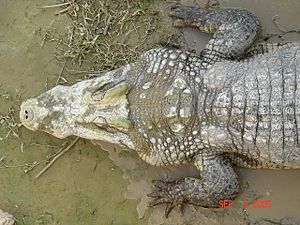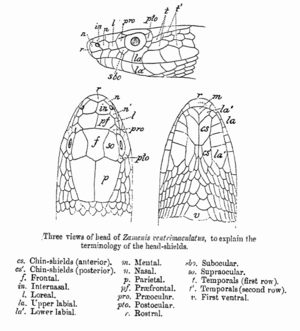Reptile scale facts for kids
Reptiles are amazing animals, and one of the things that makes them special is their skin! Unlike mammals with fur or birds with feathers, reptiles have skin covered in tough structures called scales or scutes. These coverings help protect them and are a key way to tell reptiles apart from other animals.
Reptile scales are made of strong materials called alpha-keratin and beta-keratin. These are the same types of proteins found in your fingernails and hair! The scales grow from the outer layer of the skin, called the epidermis. This is different from fish scales, which grow from a deeper skin layer. Reptile scales can be bony, bumpy, or even specially shaped, like those on snakes.
Contents
Lizard Scales: Tough and Varied
Lizard scales come in many shapes and sizes. Some are bumpy, like small knobs, while others are flat and overlap like roof tiles. The surface of these scales is made of tough, hardened epidermis. Underneath, some lizard scales can have bony plates called osteoderms. These bony plates add extra protection. The way lizard scales look can be very different on various parts of their body. Scientists often use these differences to tell different lizard species apart.
Snake Scales: Protection and Movement
Snakes are completely covered in scales. These scales do many important jobs for the snake:
- They protect the snake's body from harm.
- They help the snake move by gripping surfaces.
- They help the snake keep moisture inside its body, which is important for living in dry places.
- They create colorful patterns that help the snake hide (camouflage) or warn predators away.
Some snakes have even changed their scales over time for special uses. For example, some have scales that look like eyelashes, and others have clear scales that protect their eyes. The most famous special scales are the rattles on rattlesnakes, which they shake to make a warning sound.
Snakes regularly shed their old skin, including their scales. This process is called moulting. It allows them to replace worn-out skin, get rid of parasites, and helps them grow bigger. The unique shapes and patterns of a snake's scales are very helpful for identifying different snake species. Scientists can even count the scales on a snake's belly and back to learn about its bones without cutting it open!
Scutes: Bony Plates for Protection
In animals like crocodiles and turtles, their tough outer covering is called scutes. These are different from typical scales because they form from a deeper layer of skin, the dermis, and don't usually overlap like snake scales. Scutes are like bony armor plates. You can also see similar scutes on the feet of birds and the tails of some mammals. Scientists believe these bony scutes might be the original type of skin armor in reptiles.
Ecdysis: The Shedding Process
The shedding of skin and scales is called ecdysis, or more commonly, moulting or sloughing. This process is very important for reptiles.
Moulting helps reptiles in a few ways:
- It replaces old, worn-out skin with new, fresh skin.
- It helps them get rid of annoying parasites like mites and ticks.
- For some animals, like insects, shedding skin allows them to grow. While this is debated for snakes, it's a common belief.
When lizards moult, their skin usually comes off in small flakes. However, some lizards, especially those with long bodies, might shed their skin in one piece. Interestingly, some geckos will even eat their own shed skin!
For snakes, the entire outer layer of skin comes off in one complete piece. Snake scales are not separate pieces; they are part of this outer skin layer. So, when a snake sheds, it's like taking off a sock that's been turned inside out! This happens regularly throughout a snake's life.
Before a snake sheds, it often stops eating and finds a safe place to hide. Its skin might look dull and dry, and its eyes can become cloudy or blue. When it's ready, the old skin breaks near the snake's mouth. The snake then wiggles and rubs against rough surfaces to help peel the skin off. Often, the skin peels backward from head to tail, just like an old sock. Underneath, a new, brighter, and often larger layer of skin has already formed.
Younger snakes, who are still growing quickly, might shed their skin up to four times a year. Older snakes, however, may only moult once or twice a year.
Images for kids





